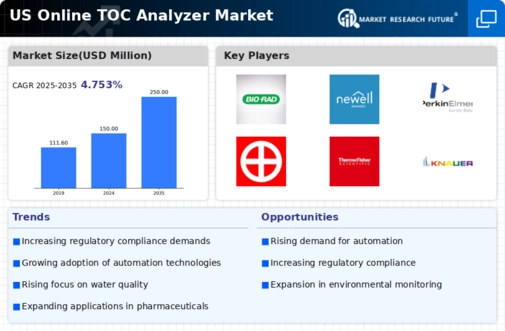Growing Focus on Process Optimization
The emphasis on process optimization across various industries is a key driver for the on line-toc-analyzer market. Companies are increasingly recognizing the importance of maintaining optimal operational conditions to enhance productivity and reduce costs. The on line-toc-analyzer market is benefiting from this trend, as these analyzers provide real-time data that enables organizations to make informed decisions. Industries such as pharmaceuticals and food and beverage are particularly focused on optimizing their processes to ensure product quality and safety. The market for process optimization solutions is projected to grow significantly, with an expected CAGR of 7% through 2025, indicating a favorable environment for the on line-toc-analyzer market.
Environmental Regulations and Compliance
Stringent environmental regulations are significantly influencing the on line-toc-analyzer market. In the US, regulatory agencies are enforcing stricter guidelines for wastewater treatment and discharge, necessitating the use of advanced monitoring technologies. The on line-toc-analyzer market is responding to these regulatory pressures by providing solutions that ensure compliance with environmental standards. For instance, the EPA has set limits on total organic carbon (TOC) levels in effluents, which has led to increased adoption of on line-toc-analyzers in various sectors. This regulatory landscape is expected to drive market growth, as companies invest in technologies that not only meet compliance requirements but also enhance their sustainability efforts.
Rising Demand for Water Quality Monitoring
The increasing awareness regarding water quality and safety is driving the on line-toc-analyzer market. As consumers and industries alike prioritize clean water, the demand for effective monitoring solutions has surged. In the US, the market for water quality testing is projected to reach approximately $4 billion by 2026, indicating a robust growth trajectory. This heightened focus on water safety is compelling municipalities and industries to invest in advanced on line-toc-analyzer technologies. Furthermore, regulatory bodies are emphasizing the need for continuous monitoring, which further propels the adoption of these analyzers. The on line-toc-analyzer market is thus positioned to benefit from this growing demand, as stakeholders seek reliable solutions to ensure compliance with water quality standards.
Technological Integration in Industrial Processes
The integration of advanced technologies in industrial processes is a significant driver for the on line-toc-analyzer market. Industries are increasingly adopting automation and real-time monitoring systems to enhance operational efficiency. The on line-toc-analyzer market is witnessing a shift towards smart manufacturing, where data analytics and IoT play crucial roles. This trend is expected to boost the market, as companies seek to optimize their processes and reduce waste. In fact, the industrial automation market in the US is anticipated to grow at a CAGR of 9% through 2027, which could lead to increased investments in on line-toc-analyzer solutions. As industries strive for greater efficiency, the demand for reliable and accurate monitoring tools is likely to rise.
Increased Investment in Water Treatment Infrastructure
Investment in water treatment infrastructure is a crucial driver for the on line-toc-analyzer market. As urbanization continues to rise, the demand for efficient water treatment solutions is becoming more pronounced. The on line-toc-analyzer market is poised to benefit from increased funding for water infrastructure projects, which are essential for ensuring safe drinking water. In the US, federal and state governments are allocating substantial budgets for upgrading water treatment facilities, with estimates suggesting an investment of over $100 billion in the next decade. This influx of capital is likely to stimulate the adoption of advanced monitoring technologies, including on line-toc-analyzers, as municipalities seek to enhance their water quality management systems.





















Leave a Comment